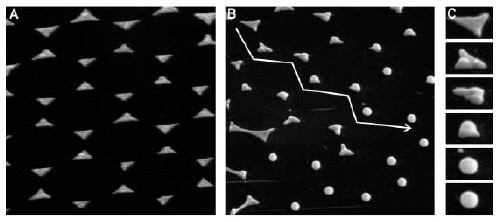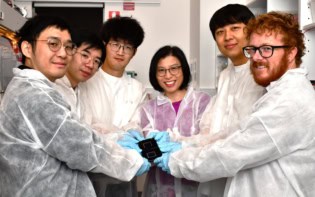Physicists in Germany have made gold nanodroplets "jump" by illuminating them with a laser. The work could lead to self-cleaning surfaces and improvements in the way that fertilisers and pesticides are spread (Science 309 2043).

When small droplets hit a solid surface they can either stick to it or bounce off it. In some applications, such as ink-jet printing and crop spraying, it is important that the droplets stick to the surface, whereas in others, such as the development of self-cleaning and water-repellent surfaces, the droplets should bounce away.
Johannes Boneberg of the University of Konstanz and colleagues in Konstanz, Munich and Freiburg used colloidal lithography to make triangular gold structures about 100 nanometres across on a graphite surface. The German team then illuminated the nanostructures with a laser pulse with a duration of a few nanoseconds.
The laser melts the gold to form a triangular droplet of molten gold. However, since gold does not naturally wet a graphite surface, the molten gold changes from a triangular shape into a sphere (see figure). This process starts at the corners of the triangles, where the radius of curvature is small and the force due to surface tension is high. In this way, the surface energy transforms into kinetic energy and the droplet detaches itself from the surface in a process called “dewetting”. The entire sequence of events takes only nanoseconds, after which the gold solidifies again. However, the nanodroplets can jump into the air at velocities of around 10 metres per second.
Previous experiments with droplets were restricted to micron-sized droplets and time scales of microseconds. The German work will allow this research to be extended to much smaller droplets and much faster time scales. Boneberg and co-workers also plan to perform the experiment under zero-gravity conditions and to investigate how droplets made from different materials behave.


